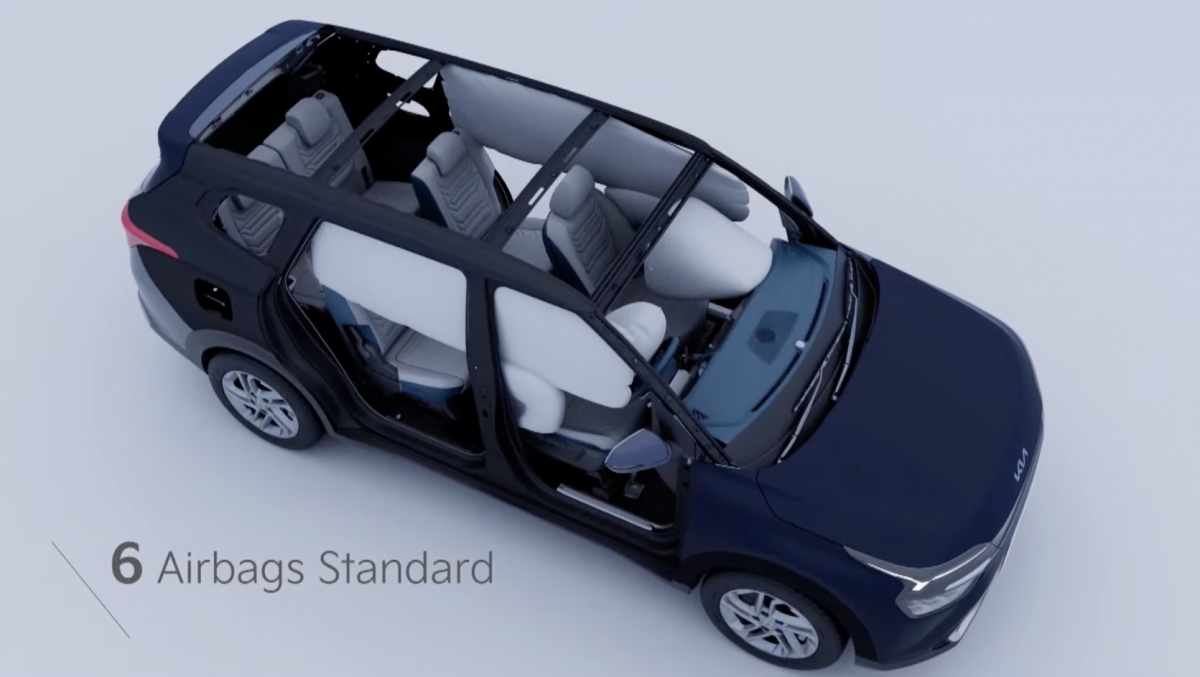The Ministry of Road Transport and Highways (MoRTH) previously proposed 1st October as the date when compulsory fitment of 6 airbags in cars was to come into effect. However, as per sources, the proposal is likely to be deferred by up to 18 months.
For the uninitiated, MoRTH issued a draft notification in January 2022 mandating 6 airbags in all cars in India. MoRTH directed all manufacturers to follow the proposed guidelines by 1st October 2022.
A senior industry executive said that the 6-month timeframe within which the ministry has to legislate a notification is now elapsed. Hence, there will likely be a reissuance of the notification. Because of this, the guidelines will likely be implemented only around April 2024.
From July 2019, the Indian government made driver airbags compulsory in all cars. Meanwhile, dual airbags became mandatory from 1st January 2022. The first draft notification for dual airbags rolled out in December 2020. The initial deadline was set as 1st April 2021 for new models and 1st June 2021 for existing models. However, after multiple deadline extensions, dual airbags in cars eventually became mandatory only at the start of 2022.
The Reasons For The Delay
Inadequate Airbag Manufacturing Capacity
According to industry sources, India simply does not have enough airbag manufacturing capacity. This is one of the main reasons behind the delay. If cars had to be compulsorily equipped with 6 airbags, airbag production will have to be nearly 18 million units a year to meet the surge in demand. This is nearly triple the current production capacity.
India’s total PV market size currently hovers around the 3 million-unit mark. In FY2022, sales were 30,45,465 units, which is a 12 per cent YoY growth. The dual-airbag mandate, which came into effect in January 2022, has already taken the total capacity requirement to about 6 million airbag units. With roughly 15 per cent of all PVs already being equipped with 6 airbags, the capacity need for airbags is presently close to 8 million units.
In case the remaining 85 per cent of the PV market was to switch to 6 airbags, there will be a requirement of an additional 10 million airbags unit capacity. Therefore, requiring suppliers to increase manufacturing dramatically to 18 million units to serve the entire market.
As per an industry expert, India does not even have a capacity of 6 million units right now. The new guidelines mean there will have to be a significant expansion in capacities and localisation of airbags and their associated parts. The latter is because, currently, manufacturers import a lot of airbag components. He added that it is impossible to cater to this demand explosion within such a short timeframe. This is despite the component makers’ willingness to invest in increasing capacities as per customer demand.
Increase In Costs
The 6 airbags mandate is great for the business of safety system suppliers. However, many fear the cost impact and engineering challenges would hurt the growth of the passenger car market. The budget segment and many popular family cars such as the Maruti Suzuki Alto, Renault Kwid, Maruti Suzuki WagonR and more would be impacted.
All such A- and B-segment cars will need a thorough re-engineering of their side-body structures. Furthermore, in some cases, it may even need a ground-up development of their platforms to conform to the 6 airbags mandate. Thus, they may lose their affordable mobility selling proposition.
According to sources, it would cost carmakers around INR 7,500 to add side and curtain airbags. However, that is not the main concern. The model redevelopment costs, as well as the lack of adequate lead time to undertake such re-engineering projects, are one of the main areas of concern.
Another top industry stated that the Indian government allowed almost 2 years of time for the dual airbags implementation in cars. However, this time, it is a much more critical implementation and will definitely need more time. He also added that it is more of a lead-time issue than an airbag cost issue.
According to estimates, the total cost of a 6-airbag system is roughly between INR 12,500 to INR 15,000 to the OEMs. However, the price increases 2 to 3 times by the time the car reaches a customer’s home. This is because of the various central and state taxes, including road tax.
Mandatory Seat Belt Reminders A Better Move
The MoRTH’s move to make dual front airbags mandatory in all cars was welcomed across the board. It was introduced strategically alongside the front seatbelt reminder alarms that became mandatory in all cars from July 2019. On the other hand, the 6 airbag proposal has received flak from all corners.
Because of the huge cost implications and without first effectively enforcing rear seatbelt usage in cars, it could end up being an unnecessary hindrance to the growth of the industry. Budget car options in India would become too expensive. This could further bring down the rates of motorisation in India, which is currently at a low 32-cars-per-thousand-people.
The recent road accident of Cyrus Mistry is a clear example that it’s the seatbelt, which is a Primary Restraint System, ends up saving lives in the event of a crash. On the other hand, an airbag forms the vehicle’s Supplementary Restraint System (SRS). This essentially assists an occupant’s seatbelt to help cushion the impact of the accident from transmitting to the human body. Therefore, the efficacy of an airbag is only achievable when the occupants are also using seatbelts.
As the industry hopes for a deadline extension for the 6 airbag rule, the MoRTH has issued a new draft notification. This draft proposes amendments to the AIS156. It suggests mandatory fitment of seat belt reminders for all front-facing rear seats in cars. As per industry experts, this could be a rather good move. This is because it will be a low-cost and more effective option than a 6 airbag mandate.
Also Read: Rear seatbelts reminder could become compulsory in India



